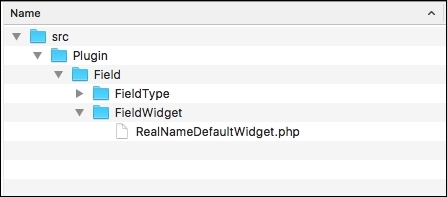Field widgets provide the form interface for editing a field. These integrate with the Form API to define how a field can be edited and the way in which the data can be formatted before it is saved. Field widgets are chosen and customized through the form display interface.
In this recipe, we will create a widget for the field created in the Creating a custom field type recipe in this chapter. The field widget will provide two text fields for entering the first and last name items.
Create a new module such as the one existing in the first recipe. We will refer to the module as mymodule throughout the recipe. Use your module's appropriate name.
- We need to create the
src/Plugin/Field/FieldWidgetdirectory in the module's base location. TheFieldmodule discovers field widgets in thePluginFieldFieldWidgetnamespace. - Create a
RealNameDefaultWidget.phpfile in the newly created directory so that we can define theRealNameDefaultWidgetclass. This will provide a custom form element to edit the first and last name values of our field:
- The
RealNameDefaultWidgetclass will extend theDrupalCoreFieldWidgetBaseclass:<?php /** * @file * Contains DrupalmymodulePluginFieldFieldWidgetRealNameDefaultWidget */ namespace DrupalmymodulePluginFieldFieldWidget; use DrupalCoreFieldWidgetBase; class RealNameDefaultWidget extends WidgetBase { } - Field widgets are like annotated plugins. Annotated plugins use documentation blocks to provide details of the plugin. We will provide the field widget's identifier, label, and supported field types:
<?php /** * @file * Contains DrupalmymodulePluginFieldFieldWidgetRealNameDefaultWidget */ namespace DrupalmymodulePluginFieldFieldWidget; use DrupalCoreFieldWidgetBase; use DrupalCoreFieldFieldItemListInterface; use DrupalCoreFormFormStateInterface; /** * Plugin implementation of the 'realname_default' widget. * * @FieldWidget( * id = "realname_default", * label = @Translation("Real name"), * field_types = { * "realname" * } * ) */ class RealNameDefaultWidget extends WidgetBase { }The
@FieldWidgettells Drupal that this is a field widget plugin. It definesidto represent the machine name, the human-readable name aslabel, and the field types that the widget interacts with. - We need to implement the
formElementmethod to satisfy the remaininginterfacemethods after extendingDrupalCoreFieldWidgetBase:/** * {@inheritdoc} */ public function formElement(FieldItemListInterface $items, $delta, array $element, array &$form, FormStateInterface $form_state) { $element['first_name'] = array( '#type' => 'textfield', '#title' => t('First name'), '#default_value' => '', '#size' => 25, '#required' => $element['#required'], ); $element['last_name'] = array( '#type' => 'textfield', '#title' => t('Last name'), '#default_value' => '', '#size' => 25, '#required' => $element['#required'], ); return $element; }The
formElementmethod returns a Form API array that represents the widget to be set, and edits the field data. - Next, we need to modify our original
RealNamefield type plugin class in order to use the default widget that we created. Update thedefault_widgetannotation property asrealname_default:/** * Plugin implementation of the 'realname' field type. * * @FieldType( * id = "realname", * label = @Translation("Real name"), * description = @Translation("This field stores a first and last name."), * category = @Translation("General"), * default_widget = "realname_default", * default_formatter = "string" * ) */ class RealName extends FieldItemBase { - Rebuild Drupal's cache so that the plugin system can discover the new field widget.
- Add a
Real namefield and use the newReal namewidget. For example, add it to aCommenttype:
Drupal core defines a plugin.manager.field.widget service. By default, this is handled through the DrupalCoreFieldFieldWidgetPluginManager class. This plugin manager defines the field widget plugins that should be in the Plugin/Field/FieldWidget namespace, and all the classes in this namespace will be loaded and assumed to be field widget plugins.
The manager's definition also sets DrupalCoreFieldFieldWidgetInterface as the expected interface that all the field widget plugins will implement. This is why most field types extend DrupalCoreFieldWidgetBase to meet these method requirements.
As field widgets are annotated plugins, the manager provides DrupalCoreFieldAnnotationFieldWidget as the class that fulfills the annotation definition.
The entity form display system uses the plugin.manager.field.widget service to load field definitions and add the field's element, returned from the formElement method, to the entity form.
The DrupalCoreFieldWidgetInterface interface defines three methods that can be overridden to provide a settings form and a summary of the current settings:
Widget settings can be used to alter the form presented to the user. A setting can be created that allows the field element to be limited to only enter the first or last name with one text field.
